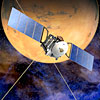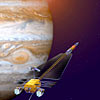|
Sunday:
February 15, 2004 | |
0225 GMT |
 |
Titan 4B rocket launches U.S. military satellite
The Defense Support Program-22 missile warning and nuclear explosion detection satellite was successfully deployed into space Saturday by a Titan 4B rocket and Inertial Upper Stage. The seven-hour launch began at 1:50 p.m. EST (1850 GMT) from Cape Canaveral, Florida.
 MISSION STATUS CENTER MISSION STATUS CENTER
 LAUNCH EVENTS TIMELINE LAUNCH EVENTS TIMELINE
 PREVIOUS TITAN 4 LAUNCH COVERAGE PREVIOUS TITAN 4 LAUNCH COVERAGE
 |  |

|
 |

Video coverage for subscribers only:
 VIDEO: THE TITAN 4 ROCKET LIFTS OFF WITH DSP-22 QT VIDEO: THE TITAN 4 ROCKET LIFTS OFF WITH DSP-22 QT
 VIDEO: 15-MINUTE CLIP OF COUNTDOWN TO TITAN/IUS SEPARATION QT VIDEO: 15-MINUTE CLIP OF COUNTDOWN TO TITAN/IUS SEPARATION QT
 VIDEO: THE DSP SATELLITE UNDERGOES LAUNCH PREPS QT VIDEO: THE DSP SATELLITE UNDERGOES LAUNCH PREPS QT
 VIDEO: DSP-22 MOUNTED ATOP ROCKET AT LAUNCH PAD QT VIDEO: DSP-22 MOUNTED ATOP ROCKET AT LAUNCH PAD QT
 VIDEO: ANIMATION OF DSP SATELLITE IN SPACE QT VIDEO: ANIMATION OF DSP SATELLITE IN SPACE QT

 VIDEO: TITAN 4 ROCKET BACKS OUT OF SMARF BUILDING QT VIDEO: TITAN 4 ROCKET BACKS OUT OF SMARF BUILDING QT
 VIDEO: THE ROCKET MAKES ITS WAY TO LAUNCH PAD QT VIDEO: THE ROCKET MAKES ITS WAY TO LAUNCH PAD QT
 SUBSCRIBE NOW SUBSCRIBE NOW

|
Photo collection shows rollback of pad tower
Just after a dense blanket of fog lifted, the mobile service tower was retracted from around the Titan 4B rocket at Complex 40 Saturday morning. Spaceflight Now's Justin Ray was at the pad and shot this gallery of photos.
 ENTER PHOTO GALLERY ENTER PHOTO GALLERY
 |  |

|
 |
Ulysses mission extended
The European Space Agency's Science Programme Committee has unanimously approved a proposal to continue operating the highly successful Ulysses spacecraft until March 2008. This latest extension, the third in the history of the joint ESA-NASA mission, will enable Ulysses to add an important chapter to its survey of the high-latitude heliosphere.
 FULL STORY FULL STORY
 |  |

|
 |
|
Saturday:
February 14, 2004 | |
0501 GMT |
 |
Titan 4 rocket poised for Florida blast off today
A mighty Titan 4B rocket will unleash over three million pounds of thrust today as it lifts off from Cape Canaveral carrying a surveillance satellite used to detect missile launches and nuclear explosions. Today's four-hour launch window opens at 1:21 p.m. EST (1821 GMT).
 MISSION STATUS CENTER MISSION STATUS CENTER
 |  |

|
 |
Twin Mars rovers continue their scientific activities
The Mars Exploration Rover Spirit is examining a collection of rocks, including a flaky one nicknamed Mimi, on its lengthy drive to a crater. Meanwhile, Opportunity is preparing to dig a hole to study the soil at its landing site.
 MISSION STATUS CENTER MISSION STATUS CENTER
 |  |

|
 |
Far away quasars probe end of cosmic dark ages
The most distant known quasars show that some supermassive black holes formed when the universe was merely 6 percent of its current age, or about 700 million years after the big bang.
 FULL STORY FULL STORY
 |  |

|
 |
|
Friday:
February 13, 2004 | |
0423 GMT |
 |
Titan 4 rocket to launch military satellite Saturday
The latest in a long line of surveillance satellites that detect missile launches and nuclear explosions is awaiting liftoff Saturday aboard a Titan 4B rocket from Cape Canaveral, Florida.
 MISSION STATUS CENTER MISSION STATUS CENTER
 LAUNCH EVENTS TIMELINE LAUNCH EVENTS TIMELINE
 PREVIOUS TITAN 4 LAUNCH COVERAGE PREVIOUS TITAN 4 LAUNCH COVERAGE
 |  |

|
 |

Video coverage for subscribers only:
 VIDEO: TITAN 4 ROCKET BACKS OUT OF SMARF BUILDING QT VIDEO: TITAN 4 ROCKET BACKS OUT OF SMARF BUILDING QT
 VIDEO: THE ROCKET MAKES ITS WAY TO LAUNCH PAD QT VIDEO: THE ROCKET MAKES ITS WAY TO LAUNCH PAD QT
 SUBSCRIBE NOW SUBSCRIBE NOW

|
Spitzer Space Telescope sends cosmic Valentine rose
A cluster of newborn stars herald their birth in this interstellar Valentine's Day commemorative picture obtained with NASA's Spitzer Space Telescope. These bright young stars are found in a rosebud-shaped (and rose-colored) nebulosity known as NGC 7129. The star cluster and its associated nebula are located at a distance of 3300 light-years in the constellation Cepheus.
 FULL STORY FULL STORY
 |  |

|
 |
International interplanetary networking succeeds
A pioneering demonstration of communications between NASA's Mars Exploration Rover Spirit and the European Space Agency Mars Express orbiter succeeded. While Mars Express was flying over the area Spirit was examining, the orbiter transferred commands from Earth to the rover and relayed data from the robotic explorer back to Earth.
 FULL STORY FULL STORY
 |  |

|
 |

Video coverage for subscribers only:
 VIDEO: THURSDAY'S SPIRIT AND OPPORTUNITY NEWS CONFERENCE QT VIDEO: THURSDAY'S SPIRIT AND OPPORTUNITY NEWS CONFERENCE QT
 SUBSCRIBE NOW SUBSCRIBE NOW

|
First Milstar satellite marks 10 years of service
The first U.S. Air Force Milstar communications satellite, built by a team led by Lockheed Martin, has achieved its 10-year design life of on-orbit service, providing our nation's warfighters with secure and reliable communications during military operations since 1994.
 FULL STORY FULL STORY
 |  |

|
 |
|
Thursday:
February 12, 2004 | |
0357 GMT |
 |
Beagle failure investigation formally begins
Launched on a shoestring budget, its size tightly confined, the British Beagle 2 lander headed to Mars for a highly-ambitious mission to look for evidence of life. A Christmas Day touchdown on the Red Planet was planned, but the craft never phoned home and subsequent weeks of searching turned up only silence.
 FULL STORY FULL STORY
 |  |

|
 |
Cold motor causes Spirit to remain parked for a day
A missed communications window caused by a cold antenna motor on the Mars Exploration Rover Spirit prevented the robot from racking up any additional distance on its odometer Tuesday night.
 FULL STORY FULL STORY
 |  |

|
 |
Gravitational lens reveals heart of a distant galaxy
Many examples are known where a galaxy acts as a gravitational lens, producing multiple images on the sky of a more distant object like a bright quasar hidden behind it. But there has been a persistent mystery for over 20 years: Einstein's general theory of relativity predicts there should be an odd number of images, yet almost all observed lenses have only 2 or 4 known images. Now, astronomers have identified a third, central image of a lensed quasar.
 FULL STORY FULL STORY
 |  |

|
 |
|
Wednesday:
February 11, 2004 | |
0031 GMT |
 |
Spirit rover establishes new Mars driving record
The rover Spirit drove into the Martian history books Monday night by making the longest single-day traverse on the Red Planet, eclipsing the mark set by Mars Pathfinder's Sojourner rover in 1997.
 FULL STORY FULL STORY
 |  |

|
 |
Reactor research to power journey to Jupiter's moons
A planned U.S. mission to investigate three ice-covered moons of Jupiter will demand fast-paced research, fabrication and realistic non-nuclear testing of a prototype nuclear reactor within two years, says a Los Alamos National Laboratory scientist.
 FULL STORY FULL STORY
 |  |

|
 |
Mars Express spies Valles Marineris region
This image was acquired by the European Space Agency's Mars Express orbiter from an altitude of 275 km above the Red Planet. The features in the picture indicate erosional processes possibly caused by water.
 FULL STORY FULL STORY
 |  |

|
 |
|
Tuesday:
February 10, 2004 | |
0623 GMT |
 |
Orbiter sees Opportunity rover on the Martian surface
As navigation experts pinpoint the rover Opportunity's precise location, the orbiting Mars Global Surveyor has spotted the craft sitting in a small crater. In other news Monday, scientists are working to understand mysterious spherical grains scattered around the landing site that the rover's microscopic imager is examining.
 STATUS REPORT STATUS REPORT
 |  |

|
 |

Video coverage for subscribers only:
 VIDEO: ORBITER SPOTS OPPORTUNITY IN CRATER W/NARRATION QT VIDEO: ORBITER SPOTS OPPORTUNITY IN CRATER W/NARRATION QT
 VIDEO: ENGINEER PRESENTS BOUNCING PATH INTO THE CRATER QT VIDEO: ENGINEER PRESENTS BOUNCING PATH INTO THE CRATER QT
 VIDEO: OPPORTUNITY SEES BACKSHELL & CHUTE W/NARRATION QT VIDEO: OPPORTUNITY SEES BACKSHELL & CHUTE W/NARRATION QT
 VIDEO: SCIENTIST EXPLAINS ROCK IMAGES FROM OPPORTUNITY QT VIDEO: SCIENTIST EXPLAINS ROCK IMAGES FROM OPPORTUNITY QT
 VIDEO: UPDATE ON SPIRIT'S ROCK STUDY FROM SCIENTIST QT VIDEO: UPDATE ON SPIRIT'S ROCK STUDY FROM SCIENTIST QT
 VIDEO: SPIRIT RESUMES DRIVING & USES ITS OWN NAVIGATION QT VIDEO: SPIRIT RESUMES DRIVING & USES ITS OWN NAVIGATION QT
 VIDEO: MONDAY'S MARS ROVER NEWS CONFERENCE QT VIDEO: MONDAY'S MARS ROVER NEWS CONFERENCE QT
 SUBSCRIBE NOW SUBSCRIBE NOW

|
Scientists find ozone-destroying molecule
Using measurements from a NASA aircraft flying over the Arctic, Harvard University scientists have made the first observations of a molecule that researchers have long theorized plays a key role in destroying stratospheric ozone, chlorine peroxide.
 FULL STORY FULL STORY
 |  |

|
 |
|
Monday:
February 9, 2004 | |
0001 GMT |
 |
One rover set to cruise, other in science mode
The Mars Exploration Rover Spirit was to leave its first rock subject late Sunday and begin the long journey toward an impact crater, a day later than planned after a self-imposed software hold. Meanwhile, Opportunity has commenced its examination of the rock outcropping at its landing site by taking amazing microscopic images.
 FULL STORY FULL STORY
 MISSION STATUS CENTER - updates! MISSION STATUS CENTER - updates!
 |  |

|
 |

